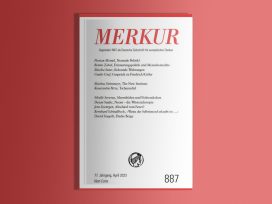On 9 November 2009, the world’s news media turned its gaze toward Berlin. There, political leaders from all of the victorious powers of World War II – Prime Minister Gordon Brown from the United Kingdom, French President Nicolas Sarkozy, Russian President Dmitri Medvedev and Secretary of State Hillary Clinton from the United States – had gathered, along with Germany’s Chancellor Angela Merkel and thousands of spectators on the city streets, to witness the symbolic toppling of the Berlin Wall. It was exactly 20 years after the border between East and West Berlin was opened as part of the political process that is usually called, in a stale metaphor, The Fall of the Wall.
The wall of 2009, however, consisted of 1000 gigantic dominoes, painted by professional artists, but also by children and youth from different parts of the world, and lined up in a long row from Potsdamer Platz via Brandenburger Tor, all the way to the German parliament. In a visual, not to say over-explicit staging, the first domino in the wall was toppled by Lech Walesa, former leader of Solidarity and later President of Poland during the 1990s.
The whole setting exuded unity – representatives of different countries and different political cultures and parties in a convivial gathering. Perhaps this was the actual ending point for World War II, with top political representatives both from the victorious nations and from defeated Germany. A happy ending. But there are probably some people who, in various ways and for different reasons, feel uncomfortable at the sight of how a complex political and historical process is staged through such a seemingly unequivocal endpoint.
However, I would like to take as a starting point something that might be considered a rather insignificant detail in this context, namely why the giant bricks that were toppled were first painted. The reason is, of course, that the original wall was also painted. But the graffiti on the actual Berlin Wall was on the West side and it was put there without permission. This can be hard to remember when the only sizeable piece of painted Berlin Wall that remains today is the so-called East Side Gallery, an approximately 1-kilometre-long painting along the River Spree near Ostbahnhof. It was created, with permission, on the eastern side only after the wall had lost its delimiting function, mainly by Eastern European artists and as a kind of response to the graffiti on the western side. But before November 1989, not only the wall but more specifically, the graffiti-filled West Berlin side of it, was one of the most visible political symbols of the Cold War. Out of thoughtlessness or as a concession to political unity, the “wall” of 2009 is decorated on all sides. Regardless of the reason, this would not have been possible without a large measure of forgetfulness.
Even if it might seem completely self-evident to most people, in order to understand the symbolic meaning of the graffiti on the Berlin Wall, one must remember the political polarization of the Cold War and how this intruded into all aspects of social life around the world. Most European countries belonged to one bloc or the other. Cultural life and art were also affected, both directly and indirectly. In her book The Cultural Cold War: The CIA and the World of Arts and Letters (1999), British historian Frances Stonor Saunders has shown that the US intelligence organization, the CIA, through representatives such as the Congress for Cultural Freedom, financed an extensive cultural exchange in a large number of areas.
In Germany and Berlin, the border between the two blocs did not go between countries, but straight through a city. The fact that the West side of the Berlin Wall became covered with graffiti is probably the result of a number of converging factors, but one important aspect is that the wall belonged to East Germany and that the ground on which it stood, as well as a few metres in toward the western side, was East German territory. Thus, West German police couldn’t intervene against those who painted on the wall; only GDR border police could do so, but they seem not to have shown any particular interest in the matter.
Many images and texts were spontaneously created on the wall by temporary visitors and by residents of the city. But there were also a few groups that worked more regularly and deliberately, and with greater artistic ambitions. One group consisted of youths who became inspired by New York’s subway graffiti through the expanding youth sub-culture of hip-hop during the early-1980s, and who used spray paint for their work. These youths were mainly active in the suburbs such as Märkisches Viertel, Frohnau and Schönholz in the North, and Marienfelde in the South. However, their names and their creations were less recognized than those of the group of somewhat older artists, who were mostly born in the late-1950s and early-1960s, and were connected to the West Berlin alternative movement, such as Thierry Noir, Kiddy Citny, Nora Aurienne and Christophe Bouchet. These artists painted in central Berlin, often in Kreuzberg or at symbolically poignant places such as Brandenburger Tor, Potsdamer Platz or Checkpoint Charlie – the crossing point between the earlier US and Soviet zones. Thierry Noir and his works are included in, for example, Wim Wenders’ film Wings of Desire from 1987.
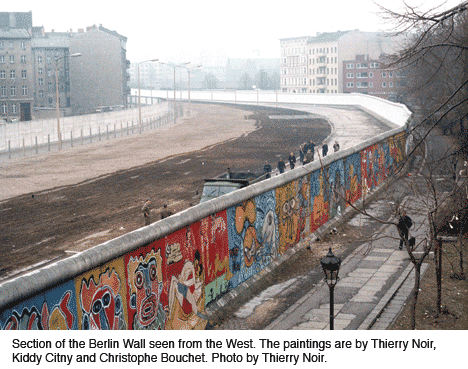
The result was a wall that constantly changed shape, and where various images and texts commented on and replaced each other in layer upon layer; where the person who painted couldn’t rely on the image or text still being there the next day. Some artists, such as Thierry Noir, chose constantly to maintain and repair their paintings, while others painted new ones instead. Toward the mid-1980s, the paintings on the wall had turned into a tourist attraction, which provoked a group of exiled East German dissidents to stage a protest. To stress the fact that the wall was a border fortification, they painted a white stripe along the wall. All in all, the graffiti on the Berlin Wall was more about a process than about individual works, and I think this process was influential on the view of public space and how it should be used, not only in Berlin but in large parts of the western world.
One of the many TV channels that broadcast from Berlin on 9 November 2009, was Voice of America, a state-financed US radio and TV station for broadcasts outside the United States. From its inception, the station’s explicit goal has been to promote understanding of the US and its foreign policy. One of Voice of America’s highest-profile programmes during the Cold War was Willis Conover’s jazz programme “Music USA”, which was broadcast for one hour a day, six days a week, 52 weeks a year, and which reached large parts of East Europe as well as some parts of the Soviet Union. When Conover died in 1996, the New York Times wrote:
In the long struggle between the forces of Communism and democracy, Mr. Conover, who went on the air in 1955 and continued broadcasting until a few months ago, proved more effective than a fleet of B-29s.
In the late-1950s, the US Department of State also launched an artistically ambitious touring programme called “Jazz Ambassadors”. Thus there is a direct connection here between a particular cultural expression and the politics of the Cold War.
But why jazz? The US historian Penny M. von Eschen, in her book Satchmo Blows up the World: Jazz Ambassadors Play the Cold War (2004), describes the domestic political circumstances and conflicts, as well as the complicated logic that lay behind the role of jazz in the foreign policy of the US. There we can read how Willis Conover partly saw his show as a political project, while at the same time he refused to let it be used as pure propaganda, instead holding that jazz, by definition, was a democratically individualistic form of music. Besides, jazz was popular in much of the world and it was perceived as genuinely US music: while the Soviet Union and the East European nations could boast of opera, ballet, and folk music, the US had jazz. And according to Conover, its popularity had precisely to do with freedom:
Jazz is a cross between total discipline and total anarchy. The musicians agree on tempo, key and chord structure but beyond this everyone is free to express himself. This is jazz. And this is the USA. That’s what gives this music validity. It’s a musical reflection of the way things happen in America. We’re not apt to recognize it here but people in other countries can feel this element of freedom. They love jazz because they love freedom.
Von Eschen points out that many of the jazz musicians did not share Conover’s view, but perceived democracy, civil rights and freedom as things that were worth fighting for rather than as already achieved goals. She also argues that for the participating musicians, the Department of State’s tours meant an official artistic acknowledgment that they had long been denied.
In the US mainstream press, jazz during the 1950s was still strongly linked to drugs and crime. A double view of jazz existed for a long time In the US: on the one hand it was seen as a high-cultural modern art form that crossed racial and class barriers, and on the other was linked to low-value entertainment and mass culture, as well as being linked ethnically and socially to the African-American working class. Precisely the ethnic link, however, became a political asset for the US Department of State – the presence of African-American musicians could be used as a counter-argument against the socialist countries’ accusations of institutional racism. Von Eschen argues that the discourse around the freedom and individuality of jazz has clear similarities to descriptions of abstract expressionism, but continues: “Jazz took on America’s Achilles’ heel of racism in a way that a painting by Mark Rothko or Jackson Pollock could not.”
It might seem like something of a leap from jazz to graffiti, but if graffiti is placed in even a slightly broader context, namely that of hip-hop culture, there are obvious similarities. Hip-hop culture, which along with graffiti also builds on rap music and breakdance, has much in common with jazz, both socially and culturally. The music partly builds on jazz and it originally had its social base in the African-American and Latin American working class communities of North American industrial cities. Even if no tours were ever launched by the Department of State, hip-hop was also allowed to represent the US in several important official contexts. The New York City Breakers were invited to dance for President Ronald Reagan; and in connection with the Olympic Games in Los Angeles in 1984, which were boycotted by the Soviet Union and several East European nations for political reasons, a large group of break dancers participated in the closing ceremonies.
The modern graffiti that is a part of hip-hop culture, and which is currently found in different variants on all five continents, has its roots in New York of the late-1960s and early-1970s. And just as with jazz, two different, completely opposite narratives arose early on about how this graffiti should be viewed and treated. They are narratives that have continued to influence the importance of the image during the internationalization of graffiti during the 1980s and 1990s.
On the one hand, there is a rejective or disavowal narrative, one that mediates graffiti as pollution, fear and crime. On 21 May 1972, New York’s City Council President Sanford Garelik made a statement that garnered much attention: he explained that the graffiti on the subway trains was a form of visual and mental pollution. “Graffiti pollutes the eye and mind and may be one of the worst forms of pollution we have to combat.”
This narrative is also brought to the fore in the film Death Wish with Charles Bronson, which has attracted the attention of US cultural historian Joe Austin. He points out that this narrative is founded on an image of the graffiti artist that has distinct ethnic and social overtones built on the stereotype of “the boogie man” – a coloured man from a poor neighbourhood. At the same time, this graffiti artist is made completely anonymous, constructed in the media as an object who is never referred to as an independent individual. What is emphasized in the rejecting narrative is the group, or the gang, that creates urban problems and fear.
On the other hand, there is a consenting or even affirming narrative that deals with graffiti as an exciting artistic expression by creative youths. This narrative received one of its earliest and most widely-disseminated expressions in March 1973 through an article by Richard Goldstein in New York Magazine. In a quote that can be considered especially illuminating as a contrast to Garelick’s, Goldstein argues that graffiti is the healthy and genuine expression of a youth culture:
Graffiti is the first genuine teenage street culture since the fifties [] it just may be that the kids who write graffiti are the healthiest and most assertive people in their neighborhoods.
In this article, there is also an often-quoted statement by the artist Claes Oldenburg, where he compares subway graffiti to colourful bouquets of flowers from South America. In this consenting narrative as well, there are obvious ethnic and social assumptions similar to those in the rejecting narrative, even if they are not as stereotypical. But here the practitioners are of course not anonymous vandals, but are allowed to appear as distinct subjects. In the same issue of New York Magazine, four graffiti writers are interviewed, complete with portraits, names and artist names, as well as geographical locations. What is emphasized in the consenting discourse is the healthy individual who makes an individual imprint on the tough and anonymous life of the city.
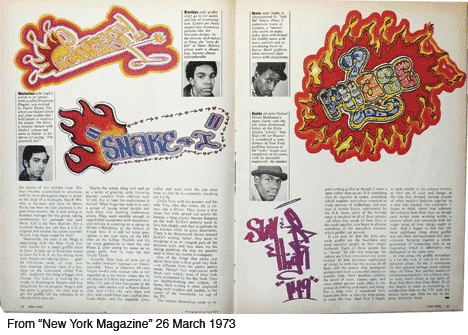
The symbolic meaning of the graffiti on the Berlin Wall arises in the tension between these two narratives, where it is integrated into the North American and West European identity with ideologically charged keywords such as “freedom” and “individualism”.
With the Berlin Wall, both the rejecting and the consenting narratives take hold, and both are given a positive value. Within the consenting narrative, the graffiti on the wall appears as the result of the creativity of free individuals, individuals who rise up against a society of control. Within the rejecting narrative, on the other hand, graffiti becomes a symbolic destruction and pollution of something that is both a hateful symbol and a political reality.
Not only spontaneous, but also “institutionalized” graffiti was painted on the wall. As early as 1982, Museum Haus am Checkpoint Charlie announced an international competition with the slogan “Overcoming the Wall through Art”. Later the same year, in connection with the noted exhibition “Zeitgeist” at the Martin-Gropius-Bau, Jonathan Borofsky painted a running white figure on the wall outside the museum. But the single most famous painting was made in 1986 by the US artist Keith Haring, officially invited by Museum Haus am Checkpoint Charlie and protected by US military forces. The meeting between the symbolically charged wall and the famous artist received an enormous media reception, which Haring himself commented on:
For me, the Berlin wall was probably one of the most successful media event things I ever did. The whole reason almost for doing the wall was more for the idea of doing it, and almost as a gesture, more than it was to actually paint a wall. I mean there’s the wall that represents the dividing of east and west, and this of lack of freedom – and the conflict that’s all over the world.
Haring stressed that his painting was not derogatory of the GDR, and that he saw it as a political gesture, which he hoped would reach beyond the political domain – for him the wall represented the fracture and lack of freedom all over the world. As an outspoken homosexual male with the rights of sexual and ethnic minorities on his agenda, Haring was also, as were many of the jazz musicians that von Eschen wrote about, much more politically radical than the political administration of his homeland. He participated in ACT UP (AIDS Coalition to Unleash Power) and was one of the most noted critics of the Reagan Administration’s unwillingness to take the disease seriously.
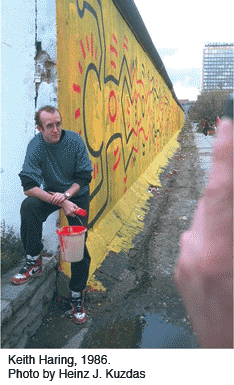
At the same time, the placement at the border crossing Checkpoint Charlie was one of the most symbolically charged transitions between the Cold War’s two geopolitical zones. So regardless of Haring’s particular message, the painting is inscribed into a meta-narrative that takes little notice of nuances. In fact, his dissenting political stance appears as an amplification of such concepts as freedom and individualism. The result is that the graffiti on the Berlin Wall is linked not only to creativity, but also to freedom. The images of the graffiti-covered Berlin Wall spread this narrative all over the western world.
Since 1989, the Berlin Wall has undergone great changes – physically and legally, of course, but also mentally and symbolically. In the city of Berlin it is almost completely gone, preserved only in a very few places and then as a memorial monument. The best-preserved section is located at the Berlin Wall Monument and Documentation Centre on Bernauer Strasse, but there all the graffiti has been removed. East Side Gallery, the eastern side of the wall that was painted directly after the border was opened, is now a protected cultural site, but there are mainly traditional murals here. The element of process that characterized the visual culture of the West side, with its constant comments, additions, over-paintings and re-paintings is considered a problem. The West side of the East Side Gallery, facing toward the River Spree, was for a long time one of the few sections that remained free for use and where the process continued. In 2009, when the symbolic wall was first painted and then torn down in November, even most of this surface has been cleaned and the former border zone has been transformed into a well-groomed park located between the Spree and a large sports arena.
Large parts of the Berlin Wall have changed ownership. Partly, small fragments of the wall that had been chiselled out by the so-called Mauerspechte – those who used chisels and hammers to demolish large parts of the wall in the months following the opening of the border – were sold. Larger parts of the wall were also sold at an auction in Monte Carlo in 1990 and then spread around the world. In the Vatican, for example, there is part of the wall with a painting by the Iranian painter Yadiga Azizy that depicts St. Michael Church; when the painting was made, this was on the other side of the wall.
How are we to understand these large and small fragments of the Berlin Wall that are spread around the world? The artist Thierry Noir, who has his work on several of the larger fragments, argues that they should simply be seen as peace symbols. In certain cases, that may not be an unreasonable interpretation. But when they end up, for example, at the Ronald W. Reagan Presidential Library and Museum, they appear more as a victory trophy for the victors of the Cold War. Especially when the fragment is provided with an explanatory sign:
An authentic section of the Berlin Wall, donated in April 1990 by the Berlin Wall Commemorative Group to President Reagan for his unwavering dedication to humanitarianism and freedom over communism throughout his presidency. This segment measures 3,5 feet by 10 feet, and weights approximately 8000 pounds.
It is quite clear that different parts of the wall are used to create different narratives in different contexts.
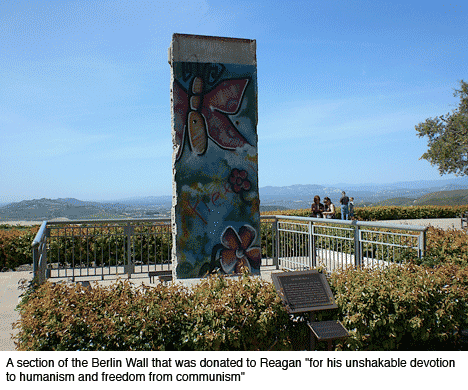
In 1992, in his book The End of History and the Last Man, Francis Fukuyama presented an idea that attracted much attention, essentially arguing that with the end of the Cold War, liberal democratic ideology had won, and that in a certain sense history had thereby ended. This is a frightening thesis if conflict and the tension between viewpoints and opinions are considered the very driving force for political processes. Regardless of the plausibility or implausibility of the thesis, it provoked a strong response in dominant political circles both in Europe and the US. Thus it is not strange that the destruction of the Berlin Wall coincides with two clear tendencies in western culture of the 1990s: an increased privatization and commercialization of public spaces, where the citizen is more and more often redefined as a consumer; and an increased control and guarding of the same spaces, where deviant behaviours are stigmatized and criminalized.
It is also in the light of these tendencies that one must understand the launching of so-called zero tolerance by New York City’s Mayor Rudy Giuliani in the early-1990s – a policy that in effect means that the police prioritize small crimes and disturbances of the peace in public spaces. With this policy, graffiti seriously came under fire, for it had by now largely exhausted its role as a symbol of freedom. But it was probably also the other way around: that the graffiti on the Berlin Wall before 1989 was a seemingly small but ideologically and visually important contribution to the identity of public spaces, an identity that included something beyond a possible place for consumption.
No contemporary graffiti artists were invited to participate in the painting of the symbolic wall that was torn down in Berlin on 9 November 2009. However, Thierry Noir and Kiddy Citney were invited to paint one of the parts. But regardless of whether the paintings were created by children or by professional artists, they had no political power to reach beyond their immediate circumstances of their production. Instead of the wall’s political or cultural history, the event highlighted and reinforced the painted wall’s meaning as a tourist attraction – but in November 2009, there were no longer any protesting dissidents who marked their distaste with a painted white line.










